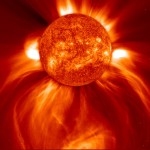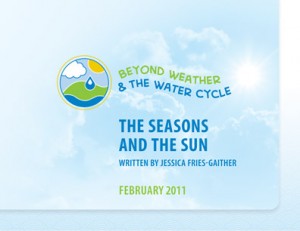
Coronal ejections from the Sun. Image courtesy of SOHO/LASCO consortium. SOHO is a project of international cooperation between ESA and NASA.
In this informational text, elementary students learn about the Sun, its role in heating the Earth’s air, land, and water, and its connection to our seasons and weather. The text can be used in conjunction with the lessons featured in the article Lessons about the Sun and Earth’s Climate. The text also encourages students to observe the Sun’s impact on the weather and the seasons and make predictions about future changes. Learn more about making predictions in the articles Making Predictions: A Strategy for Reading and Science Learning and Lessons about Making Predictions with Informational Text.
Versions of this text are available at the K-2 and 3-5 grade bands. The Flesch-Kincaid reading level of each version is provided following the text. Each version is available as a text document, a full-color illustrated book (downloadable PDF documents) that you can print, copy, and use with your students, and an electronic version with recorded audio narration. The two reading levels can help you differentiate instruction for your students.
Finally, we’ve provided related resources to help your students learn more about the Sun. Have other favorite resources? Share them with us in the comments section!
GRADES K-2
 The Seasons and the Sun
The Seasons and the Sun
by Jessica Fries-Gaither
We have four seasons on Earth. Can you name them?
Right! The four seasons are winter, spring, summer, and fall. Each season has different weather.
Winter is cold. It might snow or rain a lot.
Spring is warmer than winter. In some places spring is rainy.
Summer is warm, or even hot!
And fall is cooler than summer.
All of the seasons depend on the Sun. But what does the Sun have to do with the seasons?
The Sun’s light shines on Earth. The light makes our air, land, and water warm.
The Sun shines on Earth every day. Even on cloudy days. But there isn’t the same amount of sunlight in each season.
There are fewer hours of sunlight in winter. That makes it colder.
There are more hours of sunlight in summer. That makes it warmer.
Have you noticed the Sun today? Is it sunny outside? Or is it cloudy? Will it get dark early tonight?
Spring, summer, winter, or fall – the Sun makes a big difference for us all.
Flesch-Kincaid RL = 1.7
Access this Grades K-2 text as a text-only document.
Access this Grades K-2 text as a full-color illustrated book.
Access this Grades K-2 text as an electronic book.
Notes for assembling the illustrated books:
You can put this book together a couple of different ways. You can print out the pages, cut them in half and then order the pages back to front. Fold the stack in half and then staple the spine of the book. Pairs of pages can then be stapled or glued along the right edge.
You can also assemble the book as a foldable book.
To assemble the books this way, print the four pages and align the document pages so that the following book page numbers are in the lower right-hand corner: front page, page 6, page 2, and page 4. (The cover page should be on top and page 4 on the bottom.) Set your copier to copy single pages into double pages and run the four document pages in the order specified. Cut along the dotted line in the center of the double-sided page, place the book pages in order, fold, and staple along the spine.
GRADES 3-5
The Seasons and the Sun
by Jessica Fries-Gaither
Rain, wind, snow. What’s the weather like where you live?
We have four seasons on Earth. In most places, each season has different weather. Summer is warm, or even hot! Winter can be cold and snowy or rainy, depending on where you live.
The seasons usually have different weather. But they do have something in common. All the seasons depend on the Sun.
What does the Sun have to do with the seasons? Everything!
The Sun’s light shines on Earth. That light makes Earth’s land, air, and water warm. This warmth is important. It makes life on Earth possible. It also has a lot to do with our seasons.
Even if we can’t always see the Sun, its light is important all year round. There are fewer hours of daylight in the winter. The Sun rises later and sets earlier. This means that temperatures are colder.
In the summer, there are more hours of daylight. The Sun rises earlier and sets later. This means that temperatures are warmer. In the spring and fall, there are fewer hours of daylight than in the summer, but more than in the winter. And the temperature is in-between, too.
At the North and South Poles, the seasons are extreme. In the winter, the Sun doesn’t rise for several months. In the summer, the Sun doesn’t set for several months. The North and South Poles have cool (or cold) temperatures year-round.
There is one place on Earth where the seasons aren’t all that different. That place is the equator. Near the equator, there is always the same amount of daylight. Temperatures are always very warm, or even hot.
So, for most places on Earth, the seasons change because of the Sun.
What have you noticed about the Sun this season? Keep an eye on the amount of sunlight each day and you will know when the seasons are changing.
Flesch-Kincaid RL = 3.5
Access this Grades 3-5 text as a text-only document.
Access this Grades 3-5 text as a full-color illustrated book.
Access this Grades 3-5 text as an electronic book.
Notes for assembling the illustrated books:
You can put this book together a couple of different ways. You can print out the pages, cut them in half and then order the pages back to front. Fold the stack in half and then staple the spine of the book. Pairs of pages can then be stapled or glued along the right edge.
You can also assemble the book as a foldable book.
To assemble the books this way, print the four pages and align the document pages so that the following book page numbers are in the lower right-hand corner: front page, page 6, page 2, and page 4. (The cover page should be on top and page 4 on the bottom.) Set your copier to copy single pages into double pages and run the four document pages in the order specified. Cut along the dotted line in the center of the double-sided page, place the book pages in order, fold, and staple along the spine.
RELATED RESOURCES
Observe Sunrise and Sunset (Grades K-5)
In this segment produced for Teachers’ Domain, observe time-lapse video of a sunrise and a sunset.
The Shiniest Moon (Grades K-5)
This informational text from the Beyond Penguins and Polar Bears online magazine explores the concept of albedo, or the amount of light reflected by an object. Students in grades 4-5 learn about two of Saturn’s moons, albedo, the relationship between heat absorption and temperature, and how decreasing sea ice in the Arctic actually contributes to further melting. Modified versions are available for younger students. Students in grades K-1 investigate the difference in heat absorption between light and dark colors. Students in grades 2-3 are introduced in a simplified manner to the light absorption and reflection of different surfaces on Earth. The article includes links to the text-only, illustrated book, and electronic book formats as well as related activities.
Our Very Own Star: The Sun E-book (Grades 2-5)
In this interactive electronic book, students learn about the Sun and its importance to life on Earth. A Spanish version is also available.
Our World: The Sun, A Real Star (Grades 3-5)
In this 5:25 video clip, learn about the important relationship between Earth and the Sun. Find out about the layers of the Sun and how Earth’s magnetosphere acts like a giant handkerchief to protect us from all kinds of space weather. Part of NASA’s K-5 Our World video collection. To access this particular video, make sure that the K-5 box is checked and scroll down to find The Sun, A Real Star.
Characteristics of the Sun (Grades 3-5)
Our Sun is an ordinary star — just one of billions of stars in our galaxy alone. However, as our own star, the Sun holds special status for us and is essential to our existence. The Sun’s gravity holds the solar system together, and nuclear fusion within the Sun supplies the energy for life on Earth. Without the Sun, Earth would be a drastically different place. In this video segment adapted from NASA, learn some basic facts about our Sun.
This article was written by Jessica Fries-Gaither. Jessica is an education resource specialist at The Ohio State University and project director of Beyond Penguins and Polar Bears. She has taught in elementary and middle school settings. Email Jessica at beyondweather@msteacher.org.
Copyright February 2011 – The Ohio State University. This material is based upon work supported by the National Science Foundation under Grant No. 1034922. Any opinions, findings, and conclusions or recommendations expressed in this material are those of the author(s) and do not necessarily reflect the views of the National Science Foundation. This work is licensed under an Attribution-ShareAlike 3.0 Unported Creative Commons license.


